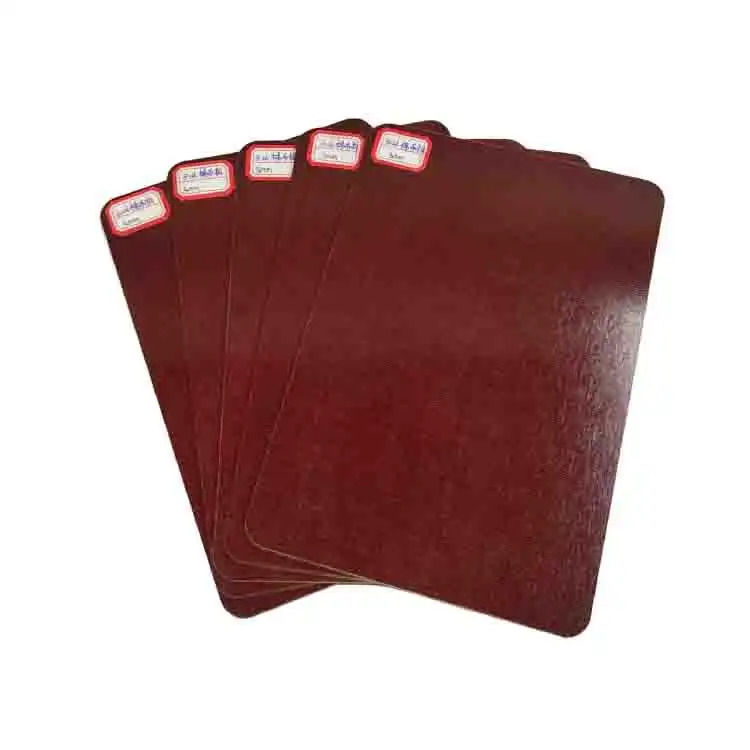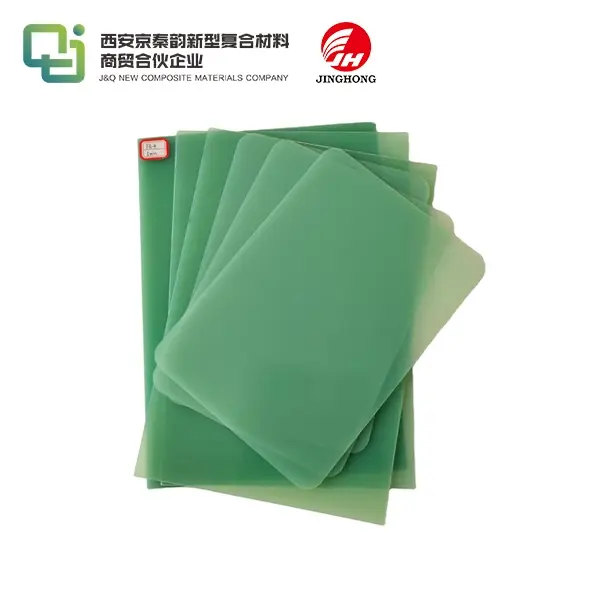What is the difference between G10 and FR4?
2024-08-09 13:57:47
When it comes to insulating materials used in electronics and various industrial applications, G10 and FR4 are two names that often come up. But what exactly sets these materials apart? In this blog post, we'll dive deep into the world of G10 and FR4, exploring their characteristics, applications, and key differences. Whether you're an engineer, manufacturer, or simply curious about these materials, this guide will help you understand the nuances between G10 and FR4 sheets.
Understanding G10 and FR4: The Basics
Before we delve into the differences, let's start with a comprehensive overview of both materials. G10 and FR4 are composite materials made from fiberglass reinforced epoxy resin, belonging to the family of glass-reinforced epoxy laminates. These materials are renowned for their excellent electrical insulation properties and mechanical strength, making them indispensable in various industrial applications.
What is FR4?
FR4, on the other hand, stands for "Flame Retardant 4" and is a specific grade of epoxy laminate sheet. It is widely used in the electronics industry, particularly in printed circuit boards (PCBs). FR4 is manufactured similarly to G10, but with a key difference: it includes a flame retardant additive. This addition provides FR4 with its crucial flame-resistant properties, which are essential for maintaining safety standards in electronic components. Beyond its flame resistance, FR4 is also valued for its excellent electrical insulation, high mechanical strength, and stability under varying environmental conditions. Its ability to maintain integrity under high temperatures and electrical stress makes it an ideal material for PCBs and other electrical applications.
What is G10?
G10 is a high-pressure fiberglass laminate, a type of composite material created by stacking multiple layers of glass cloth soaked in epoxy resin, then compressing them under heat. This results in a highly durable, stable material with exceptional mechanical properties. G10 is well-known for its outstanding strength-to-weight ratio, dimensional stability, and resistance to moisture. These characteristics make G10 a preferred choice for applications requiring high mechanical performance, such as in aerospace, marine, and industrial equipment. Additionally, G10's resistance to chemicals and extreme temperatures enhances its versatility and durability in demanding environments.
What Are the Key Differences Between G10 and FR4 Sheets?
Now that we've covered the basics, let's explore the main differences between G10 and FR4 sheets:
Flame Retardancy
The most significant difference between G10 and FR4 lies in their flame-retardant properties. FR4, as its name suggests, is specifically designed to be flame-retardant. It contains additives that help it resist burning and self-extinguish when exposed to flame. This property is crucial for applications in the electronics industry where fire safety is paramount, such as in printed circuit boards (PCBs) that must meet stringent fire resistance standards.
G10, on the other hand, is not inherently flame-retardant. While it shares many of the same base materials as FR4, it lacks the flame-retardant additives. However, G10 can be manufactured with flame-retardant additives if the application demands it, though this might affect its overall properties and cost.
Mechanical Strength
When it comes to mechanical strength, G10 generally outperforms FR4. G10 has higher flexural and tensile strength, making it more suitable for applications that require structural integrity under stress. This superior mechanical strength makes G10 an ideal choice for high-performance applications in industries such as aerospace, marine, and industrial machinery, where components must withstand significant mechanical loads without deforming or failing.
FR4, while still strong and durable, does not match the mechanical strength of G10. Its primary advantage lies in its electrical insulation and flame-retardant properties rather than its mechanical robustness.
Water Absorption
Another key difference between G10 and FR4 is their water absorption rates. G10 typically has lower water absorption rates than FR4. This property makes G10 more suitable for applications where moisture resistance is crucial. In environments where high humidity or direct water exposure is a factor, G10’s lower water absorption ensures that it maintains its structural integrity and performance.
FR4 sheet, while still relatively moisture-resistant, can absorb more water than G10. This characteristic can be a consideration in applications where prolonged exposure to moisture might lead to performance degradation.
Thermal Properties
Thermal properties are another area where G10 and FR4 differ. FR4 generally has a lower thermal expansion coefficient than G10, which means it is more stable under temperature changes. This stability is particularly important in electronic applications where thermal expansion and contraction can affect the performance and reliability of components.
G10, while having good thermal properties, can exhibit more expansion and contraction with temperature changes compared to FR4. This characteristic makes FR4 the preferred choice for electronic applications that demand high thermal stability to prevent issues such as warping or thermal stress in PCBs.
Cost
Cost is often a deciding factor in material selection, and here FR4 has an advantage. FR4 sheets are usually more cost-effective than G10 sheets, making them a popular choice for mass-produced electronic components. The widespread use of FR4 in the electronics industry has driven down its cost, making it accessible for a variety of applications without compromising on necessary properties like flame retardancy and electrical insulation.
G10, with its superior mechanical strength and lower water absorption, tends to be more expensive. Its use is justified in applications that require these enhanced properties, but for cost-sensitive projects, FR4 often provides a good balance of performance and affordability.

Applications of G10 and FR4: Where They Shine?
Understanding the differences between G10 and FR4 sheets helps in choosing the right material for specific applications. Let's look at where each material excels:
FR4 Applications
- Printed Circuit Boards (PCBs): FR4 is the most widely used material for printed circuit boards (PCBs) in the electronics industry. Its flame-retardant properties and excellent electrical insulation make it the standard choice for PCBs, which are integral to virtually all electronic devices. FR4's ability to resist burning and self-extinguish in the event of a fire ensures safety and reliability in electronic circuits.
- Electrical Insulation in Electronics: Beyond PCBs, FR4 is also used for various electrical insulation applications. It provides reliable insulation for electronic components and assemblies, helping to prevent electrical shorts and maintain circuit integrity. Its stability under electrical stress and high temperature makes it suitable for insulating electrical components in diverse electronic equipment.
- Aerospace Components: In aerospace applications, FR4 is utilized in components that require good electrical insulation and fire resistance. While not as mechanically robust as some other materials, FR4’s flame retardancy and electrical properties make it useful in certain aerospace applications where these characteristics are prioritized.
- Telecommunications Equipment: FR4 is employed in telecommunications equipment due to its excellent electrical properties and cost-effectiveness. It is used in various parts of telecommunication systems, including circuit boards and other electronic components, where its flame resistance and electrical insulation contribute to the reliability of communication systems.
G10 Applications
- High-Strength Structural Components: G10 excels in applications requiring high mechanical strength and structural integrity. It is commonly used in the manufacturing of high-strength structural components in industries such as aerospace, automotive, and heavy machinery. Its superior tensile and flexural strength make it ideal for parts that must withstand significant mechanical stress.
- Electrical Insulation in High-Voltage Applications: G10’s robust mechanical properties and lower water absorption make it suitable for high-voltage electrical insulation applications. It is used in electrical components where high strength and reliable insulation are critical, such as in switchgear, transformers, and high-voltage electrical panels.
- Mechanical Parts in Industrial Machinery: In industrial machinery, G10 is used to produce various mechanical parts that benefit from its durability and strength. Components such as gears, bearings, and structural supports are made from G10 to ensure they perform reliably under mechanical loads and harsh operating conditions.
- Marine and Underwater Applications: G10’s resistance to moisture makes it a preferred choice for marine and underwater applications. It is used in marine hardware, underwater equipment, and other environments where exposure to water and humidity is a concern. Its ability to resist water absorption ensures long-term performance and stability in such challenging conditions.
Conclusion
In conclusion, the choice between G10 and FR4 sheets depends on the specific requirements of your application. Consider factors such as flame retardancy, mechanical strength, thermal properties, and cost when making your decision. If you're unsure which material is best suited for your needs, it's always advisable to consult with experts in the field.
If you'd like to learn more about FR4 sheet, or other insulating materials, don't hesitate to reach out to us at info@jhd-material.com. We're here to help you find the perfect solution for your specific needs.
References
1. "FR-4 Epoxy Glass Laminate: Properties and Applications". IEEE Xplore Digital Library
2. "G10 and FR4 Laminates: A Comparative Study of Properties and Applications". Materials Science and Engineering
3. "A Guide to Fiberglass Epoxy Laminates: G10 and FR4 Explained". Engineering Toolbox
4. "Understanding Composite Materials: G10 and FR4 Sheets". Composites World







